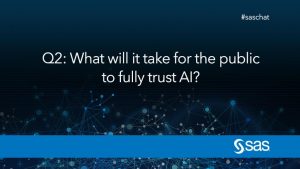 In a recent #SASchat we explored the intersection of artificial intelligence and human creativity. Posing questions like, "How is AI impacting human creativity?" And, "What will it take for the public to fully trust AI?"
In a recent #SASchat we explored the intersection of artificial intelligence and human creativity. Posing questions like, "How is AI impacting human creativity?" And, "What will it take for the public to fully trust AI?"
In the lively online conversation, a few themes prevailed:
- Automation enabled by AI frees humans from tedious tasks to focus on more visionary and creative ideas.
- Seeing real-world use cases and positive results will help the general public have more trust in AI.
- A combination of big data + AI + humans is the recipe to potentially find cures for cancer, reverse climate change and generally make our world a better place to live.
- Education on components of AI that people don’t understand will help them gain trust.
- Biased decisions can creep in as the systems are often limited by the data they’ve seen. Perhaps techniques to test AI systems before they are deployed is in order.
- Interpretable models and explainable will be essential if we are to better understand and manage AI.
I definitely want to echo @leosadovy. The automation enabled by AI potentially frees us up to focus on more visionary/creative activities. #SASchat
— Jared Peterson (@jaredpeterson) April 20, 2018
A2: I believe that people will trust AI when they experience a well positioned AI solution. E.g. a support chat in a specific industry/company where AI actually has the ability and environment to succeed in the support function #saschat
— Mads Krogh Nielsen (@MadsKroghN) April 20, 2018
As we prepared for SAS’ participation at the O’Reilly Artificial Intelligence Conference we asked a question hinging off the event theme, "What are untapped opportunities of applied AI?" Fascinating answers included:
Early childhood education
Targeted teaching evolves the curriculum in real time, in response to the child's output. Massive potential for future economic and social growth.
Customer targeting and support in the enterprise
In an enterprise environment sales, support and professional services groups can curate the intelligence already in the systems to learn about what customers want and need through active learning.
Health care sector
The healthcare industry has seen some of the most advancements within AI to date. And, according to the chat’s participants, healthcare patients are largely ready for it and we’ll continue to see the most advancements in this space.
A5 Many #AI opportunities in #Healthcare: improve patient care and wellbeing mining digital medical records, accelerate illness diagnosis (speeding up innovative technologies), new drugs discovery and development, strengthen medical imaging diagnosis #SASchat
— Garlanda Luca (@GarlandaLuca) April 20, 2018
Identification of people
Not just identify people by their biometrics but also by interviewing them and recognizing their thinking, it could have good application for border control.
A5: I am very confident that AI one day will be able to identify people - like: Really identify people, not only by their biometrics but also by interviewing them and recognizing their thinking.. That would be a first at the Border Control #saschat
— Mads Krogh Nielsen (@MadsKroghN) April 20, 2018
#saschat panelist, Paco Nathan, of O'Reilly Media also caught up with Mary Beth Ainsworth at The AI Conference in NY after her keynote to continue the conversation. Listen to their discussion on Using AI to track wildlife patterns.
See more highlights from the chat and follow the hashtag #SASchat to participate in future chats.
For more on Artificial intelligence, machine learning, deep learning and beyond check out this article as we explore the basic components of artificial intelligence and describe how various technologies have combined to help machines become more intelligent.

1 Comment
Great insights!